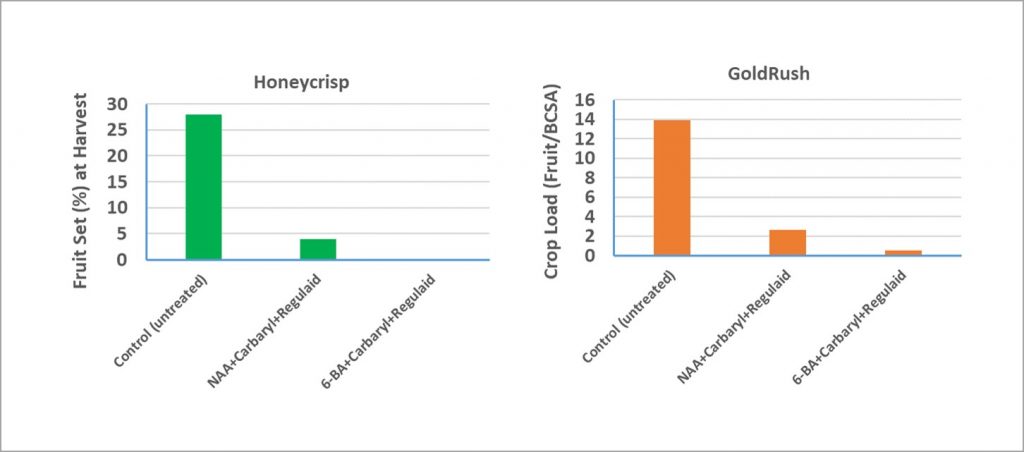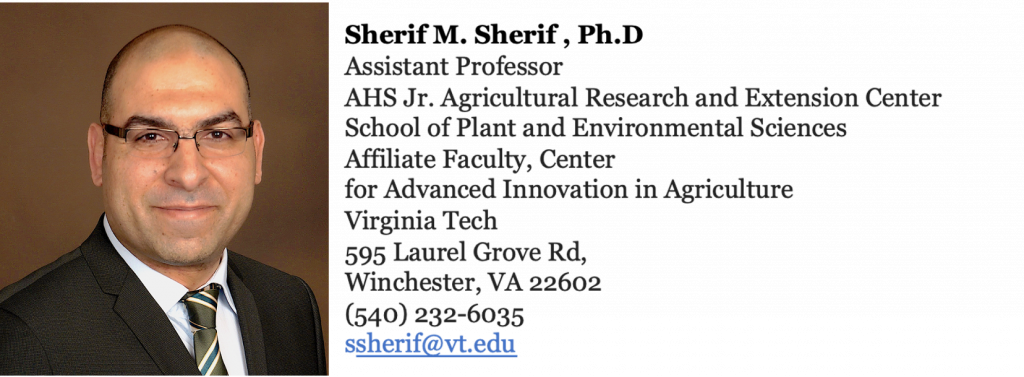Defruiting newly planted and young apple trees (e.g., 2nd and 3rd leaf) is recommended to allow trees to fill their allotted bearing space, grow to the top wire and become ready to bear a decent crop by the fourth and fifth year. This practice is particularly advisable for trees on dwarfing rootstocks (e.g., B.9, G.41, and G.16). Although defruiting can be achieved manually by removing flower clusters and small fruitlets, several chemical options can make defruiting much easier and less labor-intensive. These include:
a) Using chemical blossom thinners: Two to three applications of lime sulfur at 3% (3 gallons/100 gallon per acre) mixed with oil (e.g., JMS Stylet-oil) at 2% should be enough to prevent the fertilization and fruit set of the majority of king and side blossoms. It is worth noting that blossom thinning applications should be avoided when daytime temperatures are favorable for fire blight infections, e.g., 75° to 85°F, or when fire blight models predict blossom infections. You may also consider applying streptomycin with or after bloom thinning applications to reduce the probability of infection. The two lime sulfur products labeled for blossom thinning in Virginia are Rex lime sulfur and NovaSource lime sulfur. Our research indicated that both products are equally effective.
b) Using post-bloom thinners (recommended): Products containing 6-BA (e.g., Maxcel and Exilis plus) or NAA (e.g., Fruitone L, PoMaxa, and Refine 3.5WSG) can be applied in combination with carbaryl (e.g., Sevin XL plus) to remove apple fruitlets. One application will be sufficient at petal fall and another at fruit size 6-12 mm. 6-BA at 100 ppm (64 fl oz) or NAA at 15 ppm (6 fl oz) combined with carbaryl at 1 qt/100 gal/acre should achieve satisfactory results. Some forms of 6-BA and NAA may contain a higher percentage of the active ingredient. So, it’s always advisable to read the label and use the fl oz amounts that correspond to 100 ppm and 15 ppm of 6-BA and NAA, respectively. It should also be noted that defruiting with 6-BA or NAA is more efficient when trees are under carbohydrate deficit conditions. The carbohydrate thinning model on NEWA (http://newa.cornell.edu/index.php?page=apple-thin) predicts the carbohydrate status of the tree based on daytime temperatures and solar radiation values. The best defruting results are obtained when the 4-day average balance is between -40 to -80 g/day. If the model is not accessible, 6-BA and NAA applications should be made when daytime temperatures are ≥ 85 oF. Cloudy days at and after spray applications should also be targeted. Adding a non-ionic surfactant (e.g., Regulaid) to the spray tank will also enhance the efficacy of defruting applications.
The following figure shows the effect of two defruting treatments on fruit set (%) and crop load (fruit/branch cross-sectional area) of Honeycrisp and GoldRush.

c) Using a mixture of ethephon, carbaryl, and oil: The recommended rate for this application is 1 – 1.5 pt of ethephon tank mixed with 1 qt of carbaryl and 1 qt of Superior oil/100 gal/acre. The best results are achieved when applying this mix at 10-15 mm fruit size and daytime temperatures 75 – 90°F. It should be noted that ethephon can severely inhibit tree growth, and therefore it is not recommended to use it for defruiting weak- and medium-vigor cultivars (e.g., Granny Smith & Honeycrisp) on dwarfing rootstocks (e.g., B.9).

